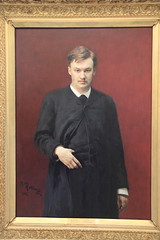Glazunov Karelian Legend (1916)
Conducted by Igor Golovschin with the Moscow Symphony Orchestra.
| Portrait of the composer Alexander Glazunov by Ilya Repin (Photo credit: Erwyn van der Meer) |
It is becoming increasingly unnecessary to defend the reputation of Glazunov. He belonged to a generation of Russian composers that was able to benefit from more professional standards of compositional technique, absorbing and helping to create a synthesis of the national, that might sometimes be expressed crudely enough, and the technique of the conservatories, that might sometimes seem facile. Glazunov worked closely with Rimsky-Korsakov, to whom Balakirev, his mother's teacher, had recommended him, and played an important part in the education of a new generation of Russian composers such as Shostakovich.
Alexander Konstantinovich Glazunov was born in St Petersburg in 1865, the son of a publisher and bookseller. As a child he showed considerable musical ability and in 1879 met Balakirev and hence Rimsky-Korsakov. By the age of sixteen he had finished the first of his nine symphonies, which was performed under the direction of Balakirev, whose influence is perceptible in the work. The relationship with Balakirev was not to continue. The rich timber-merchant Mitrofan Petrovich Belyayev had been present at the first performance of the symphony and travelled to Moscow to hear Rimsky-Korsakov conduct a second performance there. He attended the Moscow rehearsals and his meeting with Rimsky-Korsakov was the beginning of a new informal association of Russian composers, perceived by Balakirev as a threat to his own position and influence, as self-appointed mentor of the Russian nationalist composers. Glazunov became part of Belyayev's circle, attending his Friday evenings with Rimsky-Korsakov, rather than Balakirev's Tuesday evening meetings. Belyayev took Glazunov, in 1884, to meet Liszt in Weimar, where the First Symphony was performed.
In 1899 Glazunov joined the staff of the Conservatory in St Petersburg, but by this time his admiration for his teacher seems to have cooled. Rimsky-Korsakov's wife was later to remark on Glazunov's admiration for Tchaikovsky and Brahms, suspecting in this the influence of Taneyev and of the critic Laroche, champion of Tchaikovsky and a strong opponent of the nationalists, a man described by Rimsky-Korsakov as the Russian equivalent of Hanslick in Vienna, a comparison that, from him, was not entirely complimentary.
Glazunov, however, remained a colleague and friend of Rimsky-Korsakov, and demonstrated this after the political disturbance of 1905, when the latter had signed a letter of protest at the suppression of some element of democracy in Russia and had openly sympathized with Conservatory students who had joined liberal protests against official policies. Rimsky-Korsakov was dismissed from the Conservatory, to be reinstated by Glazunov, elected director of an institution that, in the aftermath, had now won a measure of autonomy. Glazunov remained director of the Conservatory until 1930.
It says much for the esteem in which Glazunov was held that he was able to steer the Couservatory through years of great hardship, difficulty and political tuffi1oil, fortified in his task, it seems, by the illicit supply of vodka provided for him by the father of Shostakovich, then a student there, Emaciated through the years of privation after the Revolution, he eventually assumed a more substantial appearance again, compared by the English press to a retired tea-planter or a prosperous bank-manager, with his rimless glasses and gold watch-chain, His appearance was in accordance with his musical tastes. He found fault with Stravinsky's ear and could not abide the music of Richard Strauss, while the student Prokofiev seems to have shocked him with the discords of his Scythian Suite. His own music continued the tradition of Tchaikovsky and to this extent seemed an anachronism in an age when composers were indulging in experiments of all kinds.
Glazunov's Karelian Legend, Opus 99, was written in 1916, shortly before the composer's Second Piano Concerto, which closes a stage in his career. In this work he turns to the disputed border region of Karelia which had already drawn the attention of Sibelius, associated as he was with those determined to end Russian domination of Finland. Glazunov's work, imaginatively scored, makes use of elements of folk-song in a colourful work, dedicated to the Latvian composer Joseph Wihtol, a pupil of Rimsky-Korsakov and for a number of years a member of the staff of the St Petersburg Conservatory, before he established himself in Riga, after 1918. The Karelian Legend opens with an idyllic picture, but the music grows in excitement and intensity, as the story unfolds, leading to a rhythmic dance and an exciting and triumphant episode, before it finally dies away.











